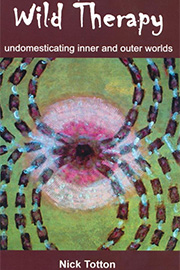Books by ERT Practitioners
Books on Relational Body Psychotherapy, Wild Therapy, Reichian Bodywork and other subjects, written by ERT practitioners. This list is not complete – we will be adding more over the coming months.
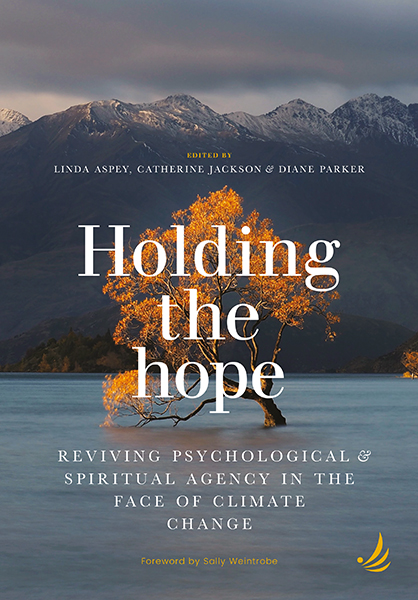
Edited by: Linda Aspey, Catherine Jackson and Diane Parker
Available from: PCCS Books
Holding The Hope: Reviving Psychological And Spiritual Agency In The Face Of Climate Change includes chapters written by Nick Totton and Emma Palmer from ERTA.
This collection explores how, in our practices and as a community, we are able to hold clients’ and communities’ fear, anger, denial, grief, helplessness and hopelessness – and be with our own – in response to catastrophic climate change and the growing reality of the destruction of Earth’s ecosystem and species extinction.
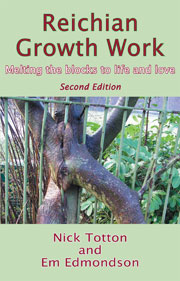
Author: Nick Totton & Em Edmondson
Available from: PCCS Books
A revised and updated new edition of a body psychotherapy classic, Reichian Growth Work sets out to convey the essential features of Reichian therapy in concrete and easily understandable language. The style of body therapy which it describes is democratic, growth-oriented and undogmatic, while still committed to Reich’s radical description of human beings and their difficulties. ‘This book is for people who want to change; because only by changing, profoundly painful as that sometimes is, can we stay alive and growing.

Author: Nick Totton
Available from: Karnac Books
Embodied Relating is addressed both to body psychotherapists and to verbal therapists, and argues that embodied relating is the soil from which all therapy grows, and that conscious understanding of this makes our work more powerful and accurate.
Embodied relating is embedded in our everyday life: we can all ‘do’ embodied relating, though some do it better than others. Like many other important aspects of life, it generally happens of its own accord, but sometimes benefits from the sort of close examination which tends to happen in therapy. However, psychotherapy has a history of keeping embodiment out of its field of awareness, and of preferring language-based relating to all other kinds – indeed, until quite recently, of downplaying here-and-now relationship altogether. All these things are now changing; and this book is intended to be part of the change.

In this short and hopefully easy-to-read book we aim to throw open some windows, to bring fresh air into the discourse about what makes a good or bad therapist and to offer some redefinitions of therapy. We suggest that therapy isn’t an expert knowledge system, open to being standardised and manualised, but is more akin to local, indigenous, embodied and relational forms of knowledge. Therapy isn’t primarily an academic activity, and we would argue is not best taught in an academic, rigorously assessed context. We are interested in questioning who sets the rules? Are the rules and expectations of how to be a good therapist the most helpful ones? In the search for high standards and protection of the client has something been lost? We believe that the core skills of being a therapist are human and innate. Rather than offering a restrictive model of what should and shouldn’t be done, training could reframe itself to look at what’s getting in the way of the practitioner’s ability to be in contact, offer intimacy, create and maintain an appropriate relationship. Training to explore how to work creatively with, rather than act out from, our wounding. Counselling and psychotherapy, especially when we work relationally, is often an unpredictable process. We will explore how to embrace the inherent messiness, awkwardness and un-knowableness, of working as a therapist.

Available from: Somatic Psychotherapy Today
What can the theory and practice of somatic/body psychotherapy, ecopsychology and Buddhism offer to each other? For the past five years, Kamalamani has shared life and work at the confluence of these fields in her quarterly Bodywise articles for Somatic Psychotherapy Today, an independent international publication representing various modalities in body psychotherapy, somatic psychology, and pre-natal and perinatal psychology. This volume brings together these quarterly Bodywise articles. Kamalamani explores client work in embodied and relational ways, drawing upon her practice of Buddhism. With her characteristically warm, immediate, accessible tone, Kamalamani encourages personal reflection and professional consideration as she offers insights illuminated by traditional Buddhist texts along with personal and clinical anecdotes that range from birth to death, from meditating with character to Reich’s character structures, from trauma and terrorized bodies to diversity, embodied spirituality and pre-natal and peri-natal psychology. She often provokingly offers more questions than answers and writes in a way that offers not only a sacred space for opening, sensing, being quiet, but also joining forces with our global communities in feeling the outrage, the love, the fear, the bliss that comes with interaction. She reminds us again and again of a whole-earth perspective, bringing sentient life and living processes into awareness in the course of everyday life, practice, and the work of healing.
NB All proceeds from this book will be donated to the ongoing costs of creating and publishing Somatic Psychotherapy Today, helping to defray the costs associated with an independently run international magazine. It is through generous gifts like Kamalamani’s and others’ who donate to Somatic Psychotherapy Today that it continues to exist.
Available as a paperback and ebook. More information on Goodreads
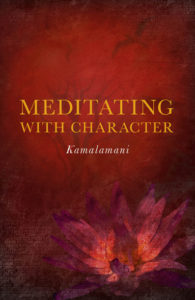
Meditating with Character invites the reader to get really curious about what goes on in their meditation practice, through understanding their embodying and disembodying habits. These habits and patterns are explored through the lens of character positions, a body of knowledge taken from post-Reichian psychotherapy. This book breaks new ground in weaving together important threads from meditation, body psychotherapy, and Buddhism, encouraging the reader to be more present with their experience of being an integrated body-mind.
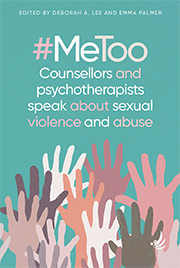
#MeToo – Counsellors and Psychotherapists Speak About Sexual Violence and Abuse (PCCS Books 2020)
Co-editors Emma Palmer (was Kamalamani) and Deborah A Lee
Available from: PCCS Books
In 2017 the global #MeToo movement burst through the conspiracy of silence around women’s experience of sexual abuse and violence. Since then, other groups have found the courage to declare that they too have experienced sexual abuse and are unafraid and unashamed to let it be known. Now this ground-breaking book provides a space where counsellors and psychotherapists – more often the listeners to such stories – can tell their own stories, sometimes for the first time. Each chapter is written by a counsellor, psychotherapist or therapy client, and followed up with a dialogue between writer and peer. Together they form a community of #TherapistsToo voices, brought together in the hope that readers both within and beyond the counselling and psychotherapy realm will feel less alone and more connected. This is a book for anyone wanting to understand the ubiquity of sexual violence and sexual abuse and how to respond, support, raise awareness, campaign and be part of creating a culture which says #TimesUp.
Therapy is by nature wild; but a lot of it at the moment is rather tame. This book tries to shift the balance back towards wildness, by connecting therapy with ecological thinking, seeing each species, each being, and each person inherently and profoundly linked to each other. Therapists have always tried to help people tolerate the anxiety of not being in control of our feelings, our thoughts, our body, our future. Human efforts to control the world are well on the way to wrecking it through environmental collapse: the more we try to control things, the further out of balance we push them. Nick Totton describes a mode of being present in all cultures, ‘Wild Mind’, and explores how this can be supported through a ‘wild therapy’, bringing together a wide range of already-existing ideas and practices, which may have a role to play in creating a new culture that can live well on the earth without damaging ourselves and other beings.
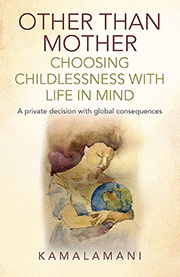
Author: Kamalamani
Available from: Earth Books
Choosing to have children is a private decision with global consequences. Other Than Mother explores the decision-making process around not having children.
What is ERT?
As human beings, we are integrated body-mindspirit; on the whole, we find this condition hard to manage. Our nature seeks to
express itself freely, while at the same time protecting itself in conditions sometimes of great difficulty. This double task of expression and protection makes us often subject to contradictory pulls, and offering double messages about what we feel, want and need. Through a relationship which is challenging but supportive and non-invasive, it is possible to disentangle our doubleness and allow our process to unfold.
Sometimes the problem is to ‘bring spirit down’ into material expression, to commit ourselves sufficiently to the recalcitrance and fixity of being in the world, rather than floating off in fantasy. Sometimes the problem is to ‘bring matter up’ into spiritual connection, to hold sufficient inspiration and enlightenment rather than getting caught in the demands of practical existence.
For each of us, there is a constantly shifting balance; also for each of us, we have certain preferences, predilections, assumptions which go to make up our character structure. This expresses itself not only in our habits of thought and behaviour, but also in our bodily and energetic patterns.
What we have just called ‘character structure’ can be usefully reframed as ‘style of relating’. There is a consonance between a person’s style of relating to the conditions of existence – to embodiment – and their style of relating to other human beings. (After all, it is through interactions with other people above all else that a baby learns what to expect from the universe and how best to respond to it.) Our nature seeks to express itself freely, while at the same time protecting itself in conditions sometimes of great difficulty. This double task of expression and protection makes us often subject to contradictory pulls, and offering double messages about what we feel, want and need. Through a relationship which is challenging but supportive and non-invasive, it is possible to disentangle our doubleness and allow our process to unfold.
ERT draws a great deal from other therapies, particularly those from the body psychotherapy tradition, and brings these ideas and techniques into a new synthesis with its own unique flavour and values. We describe this in terms of seven metaskills: Awareness, Trust, Contactfulness, Spontaneity, Spaciousness, Relaxation and Wild Mind.
Encouraging a deep letting go into what is, ERT takes a position of profound trust that what ever is trying to happen in someone’s life needs to happen, and whatever needs to happen is trying to happen.
The fundamental assumption of Embodied-Relational Therapy is that we all do the best we possibly can – the best that we know so far. Each individual has come up with a brilliant solution to the conditions in which they have found themselves – the optimum style of relating, the optimum balance between body and spirit. Equally, each person is seeking, consciously or unconsciously, to change their behavioural style in accordance with current conditions – which may be very different from the conditions in which we grew up. Whatever appears in a person’s life as a problem, a symptom, a conflict, can also be understood as an incomplete attempt to change and grow.
So the core tasks of the therapist are:
- To support all aspects of the client’s process – not just the bits we like! This is harder than it may sound, and is probably the heart of the therapeutic project.
- To identify and amplify that process, especially as it expresses itself through relationship – through the feelings each person has about the other.
- To come back, over and over, to a centred and open position, holding the space so as to allow the client free expression within it, and so as to witness every aspect of the situation including one’s own responses.
Intimacy in Embodied-Relational Therapy video
In this video I explore intimacy as a way to understand what therapy is.
Wild mind, our ecological consciousness – video
In this video I talk about Wild mind, our ecological consciousness. Wild Mind can be our route back into our connection with the wild that we live within. Reminding us of our reciprocal relationship with the air, the earth, that we are fundamentally interdependent. It offers me a hopeful way forward.
Therapy as Play Video
In this short video I offer a re-conceptualisation of therapy. Therapy as a form of play. I explore the many advantages of thinking of therapy as play, - especially for the practitioner. Play is central to my work with clients, supervisees...
Embodied Relating a Video
Embodiment and Relationship are interrelated and inseparable. In this video I explore the subtle skill set of connecting to and utilising our embodiment as a relational resource. The starting place for working relationally, is being with our own experience in the moment.
A short video to introduce Allison’s online Playing with Fire course
A short video to introduce Allison’s online Playing with Fire course. Exploring an Embodied, Relational and Wild therapeutic approach.
How to be a Bad Therapist, Nick Totton and Allison Priestman
Chapters: Good and Bad Therapists (and People); Ethics and Technique; Intimacy, Disclosure, Mutuality and Enactment; Privilege and Power; Therapy as Wild; Play and Relaxation; Conclusion.
Want to know more about working with erotic charge?
I have just created a video to introduce my thinking about how to work with this inherently embodied and relational issue.
ERT interview with Allison Priestman and Stephen Tame
In early January 2021 Katey Paradine interviewed Stephen Tame and Allison Priestman – two Embodied-Relational Therapy trainers.
October 2020 Training Update: Contact and Creativity
It feels a useful moment after nearly six months of running webinars to have a reflection on and review of my online training work and looking to the future to the next Embodied-Relational Therapy training in 2021.
Returning to Working with Clients in the Flesh – some viral thoughts
There will be risk in working with clients in the same physical space - we cannot remove all risk, and it would drive us crazy to try to do so! It's worth bearing in mind that therapeutic work necessarily involves risk, as does breathing. ...and as Eisenstein reminds...
- Freud’s Nose
by Nick Totton
Freud’s dream of Irma’s Injection is the first which he ‘submitted to a detailed interpretation’; and hence stands as a major event in the history of psychoanalysis. It is the ‘Specimen Dream’ which forms the centrepiece of The Interpretation of Dreams (Freud 1900)... - Therapy Has No Goal
by Nick Totton
In this presentation I intend to argue that the core value of psychotherapy is that it can offer a space free of all goals and intentions. This is valuable because goals, however benign, tend to be experienced as demands for their achievement; and demands are what we suffer from, what brings us into therapy in the first place, and what therapy can potentially alleviate... - We the Human Animals, Exploring an Embodied, Relational and Wild approach to Therapy.
by Allison Priestman
In this article I ask the question what does an embodied, relational and wild therapeutic approach look like? In answering, I look at my own annual withdrawal from my garden, and link it with humanities historical withdrawal from an intimate, sensual, relationship with the other-thanhuman and more-than-human. Highlighting the privileging in our culture, of rational and intellectual modes of consciousness, and the denigration of the instinctual and the wild. I offer the concept of trance states, as a way to conceptualise, working relationally with wildness, in the client therapist dyad. Wild Mind is introduced as a way to listen to the wider, wild intelligence inside us, and of which we are a part. - Embodiment & Relationship: Two halves of one whole
by Nick Totton & Allison Priestman
Book Chapter: In: C Young (ed.), About Relational Body Psychotherapy (pp 35-53) Stow, UK: Body Psychotherapy Publications. - Boundaries and Boundlessness
by Nick Totton
- Buddha Poems
by Nick Totton
- Choosing childlessness with life in mind
by Kamalamani Palmer
An exploration of the parenthood decision and childfree activism - Democracy and Therapy
by Nick Totton
- Dreaming Bodies, Dreaming the Earth
by Emma Palmer
Regular column for 'Somatic Psychotherapy Today, summer 2017 edition. - Earth-touching Buddha
by Kamalamani Palmer
This article uses the traditional image of the earth-touching Buddha to explore creative relationships between Buddhism in theory and practice, ecopsychology, Embodied-Relational Therapy, Reichian character theory and climate change politics. It describes a developing earth-based, ‘underneath’ approach to spirituality. A poem by Pablo Neruda, ‘Keeping Quiet’, twines through and dialogues with the article. - Flying free
by Kamalamani Palmer
Thoughts on not flying having heard the band 'Seize the Day' perform their song 'Flying'. - Intimacy
by Nick Totton
- Picture a body, what do you see?
by Stephen Tame
Some thoughts inspired by Nick's latest book 'Embodied Relating - the Ground of Psychotherapy' - Funny You Should Say That: Paranormality, at the Margins and the Centre of Psychotherapy
by Nick Totton
- Living on the Earth
by Nick Totton
- On Unbounded Love
by Kamalamani Palmer
In this short film Kamalamani talks about unbounded love and how it related to 'Other than Mother', her book about voluntary childlessness - Other than Mother
by Kamalamani Palmer
A guest blog post exploring bridging between the childless and the childfree - Poem: Press When Illuminated
by Nick Totton
- Power in the Therapy Room
by Nick Totton
- Sheer coincidences?
by Kamalamani Palmer
Reflections on pre and perinatal psychology in Somatic Psychotherapy Today - The “empty womb” in the therapy room? The taboo and potency of the other than mother/childfree body
by Emma Palmer (previously known as Kamalamani)
Choosing not to have children remains a quietly controversial decision. Curious about the increasing phenomenon of childlessness coinciding with a recognition of her internalised pronatal conditioning and her gradual realisation that she would not be a mother, the author started researching the parenthood decision in the late 1990s. Through autoethnography this paper explores pronatalism and prejudice towards those without child, particularly those who are voluntarily childless—now commonly known beyond academic circles as being “childfree” or “childfree by choice.” This exploration includes the lack of attention given to childfreedom in counselling and psychotherapy discourses beyond the therapy room, for example, in workshops, talks, books and papers. It recognises how therapists might offer spaces for creative dialogue about child‐bearing—or not—as well as challenging implicit and explicit pronatalism in this intimate area of life. The chapter ends celebrating the “empty womb in the room,” reclaiming the potency of the childfree, other than mother body, and the importance of women without children reclaiming the sovereignty of their bodies. The author underlines the importance of creativity as well as procreativity in the anthropocene, as we face interrelated crises, for example the sixth extinction crisis and the climate emergency, and refers to the response of the budding field of ecopsychology.

